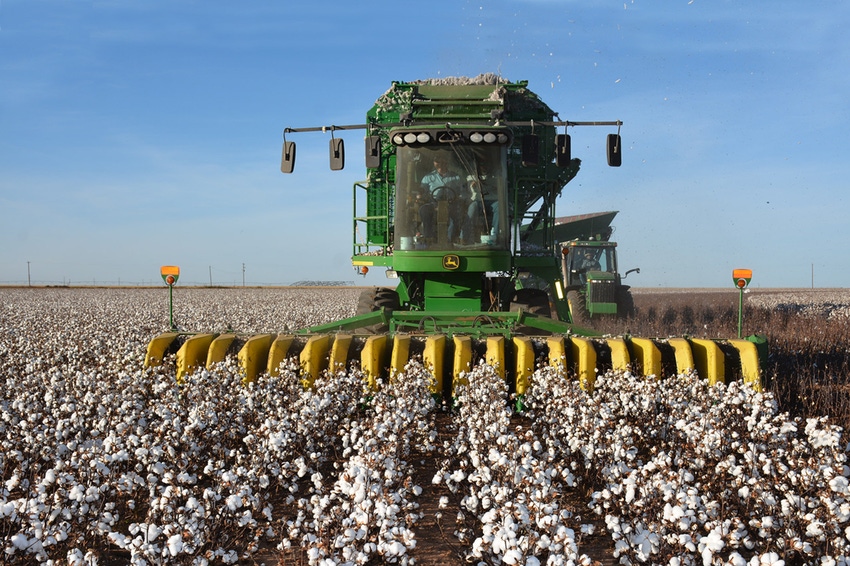
Cotton harvest on the South Plains is underway. The 2017 cotton season will easily go down as a rollercoaster year, with weather dictating some of the highs and lows growers have endured. What looked to be a promising crop in August was dampened by weeks of cool, cloudy and for many, wet weather, at the end of August extending into October. Concerns of the crop’s maturity were somewhat silenced by mid-October’s warmer temperatures and sunshine. But lower grades and gin turnout have some producers concerned--once again.
“Yields looked promising," says Preston Huguley, a Lamb County producer, who had his first cotton crop of the season stripped last week. "But, the micronaire on the cotton I’ve had ginned so far is lower than what I’d hoped for. Low mic is one of the biggest problems we often deal with in West Texas, so it’s been in the back of my mind, but I was hoping it would turn out better than it has so far.”
See harvest gallery. http://bit.ly/2zWlO6W
Timing has been a major factor in the maturity of this year’s cotton crop, whether that was the less than ideal weather or the premature application of harvest aids, according to Randy Redinger, location manager at Crop Production Services, Olton.
“Well, I definitely feel like the cool, wet weather that occurred in the last half of August and basically through the month of September, has had an effect on the maturity of the crop, at least what ‘s been harvested so far,” says Redinger. “I think there was some of this cotton that maybe harvest aids were applied a little too early, and I think that is affecting those producer’s grades. Lack of maturity in cotton definitely affects their micronaire, and it’s lower than what we would want as far as our base numbers.”
Some of the earlier opened bolls aren’t making the grade either. “Also, the open cotton that was out there during that cool, wet spell, some of it is coming back ‘light spot’ or ‘spot,’ which is staining from the wet weather. And that, of course, lowers the grade.”
Redinger says another indicator of the immaturity of this cotton can be seen at the gin. “The gin turnouts have been lower than what we’d like them to be.” An acceptable gin turnout on burr-extracted cotton would be around 32-36 percent, but Redinger says growers are reporting 28-29 percent on some of the earlier harvested cotton, a deduction that is ultimately costing them money.
“So, those are all indicators of lack of maturity in the cotton,” says Redinger.
But just as timing has been this crop’s foe, it has also been its friend. Days of warm and sunny weather allowed for continued maturation of some of the crop, while also enabling for a more timely harvest aid application. Redinger expects grades, as harvest progresses from this point, to be better and gin turnouts to be higher.
As producers and cotton harvest crews continue harvest, Cotton Incorporated reminds everyone of the following safety measures:
Always read and understand the operator’s manual for the equipment you are about to operate. Pay special attention to safety concerns and follow all safety procedures to prevent injury or death.
Operate harvesting machinery at appropriate speeds, taking into account ground conditions and slope.
Harvesting equipment is often “top-heavy.” Do not dump harvesters on sloping ground, in high winds, near electrical lines, or while moving. Make sure the rear axle stabilizer system works before dumping.
Always keep a fully charged fire extinguisher on harvesting equipment. If you detect a basket fire in time, dump the load on the ground and move the harvester away quickly. Never try to extinguish a fire from inside the basket.
At least once a day, clean seed cotton, lint, and trash from the engine compartment and other heat sources on your harvester. Keep these areas clean, and you will greatly reduce the chance of machine fires.
Always install mechanical cylinder stops or blocks before you perform maintenance on row units, under raised baskets, or under other hydraulically controlled systems. Stops and blocks will prevent the systems from lowering unexpectedly.
Wear close-fitting clothing and pay close attention when you work around harvesting equipment. Before you get near any moving part, make sure the parking brake is set and the engine is shut off.
Southwest Farm Press staff would like to wish growers a safe and bountiful harvest!
About the Author(s)
You May Also Like






